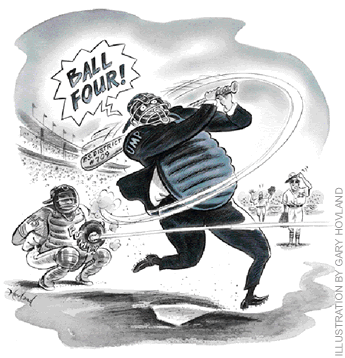
Chicago’s school district wants the federal afterschool dollar. So do many other districts. And more than two thousand private providers, for-profit and nonprofit alike, are making their own claims.
More than $2.5 billion is at stake, a figure scheduled to increase considerably if budgetary trends continue. How should the money be distributed? Will parental choice and competition among service providers determine the outcome? Or will school districts capture the resources for themselves? Can schoolchildren be the winners this time?
These questions have grown in import as afterschool programs, the heart of the supplemental service provision of No Child Left Behind (NCLB), take on increasing significance in the implementation of the historic federal law. As more and more schools fail to make their NCLB-mandated Adequate Yearly Progress (AYP) goals, the demand for supplemental education services, such as tutoring, summer school, or, most often, instruction after the end of the regular school day, is skyrocketing. Especially within big cities, where the largest concentrations of disadvantaged students reside, these afterschool programs are becoming one of the most popular features of the Bush administration’s school reforms.
The supplemental services program has major potential, but it is freighted with an inherent conflict of interest that could prove its undoing: the same school districts that are failing to make AYP are the gatekeepers for these afterschool funds. As the stakes increase, so does the funding, and so do the incentives to control those dollars.
The Legislative Compromise
To appreciate the current predicament, one need only understand that when NCLB was being hatched, afterschool was just an afterthought. The main thrust of the legislation was and remains the need to meet state proficiency standards by 2014.
But what happens when students fail to meet their AYP targets? Not much, really. For all the dire talk about the strictures NCLB places on states and localities, two of the three consequences thus far have amounted to little or nothing. Twice-failed schools (those NCLB calls “in need of improvement”) must offer parents a choice of sending their children to another public school within the district, but that option is being exercised by no more than 1 percent of eligible families. After five failing years, schools are to be “reconstituted.” Despite the dramatic verbiage, reconstitution, while it has in a few cases led to major change, usually means little more than hiring a new principal and asking teachers whether they would like to remain on the staff or move somewhere else in the district.
That leaves the third consequence, the requirement that students must be given access to supplemental services if a school fails for three years’ running. It was not supposed to be the most important result. In fact, it was born of a compromise between frustrated Capitol Hill conservatives, who saw vouchers as the accountability lever of choice, and liberals, who wanted anything but vouchers. Republicans, particularly in the House of Representatives, tossed the idea of supplemental services out as a last desperate card to avoid losing all choice options. While this seemed a backdoor way of bringing outside providers—nonprofit and for-profit, secular and religious—into the school, the legislators neglected one thing: they left the keys with the school districts. The districts could control access to students and parents and the terms of the contracts with private providers, and in many cases they could supply their own supplemental services. Even failing districts, nominally prohibited from providing such services, can divert the afterschool monies to their own use simply by suppressing parental demand for the programs, which are voluntary. Since the school districts get to keep every dollar not spent on the afterschool program and deploy those dollars for programs of their own, they have a clear financial disincentive to encourage student participation in the program.
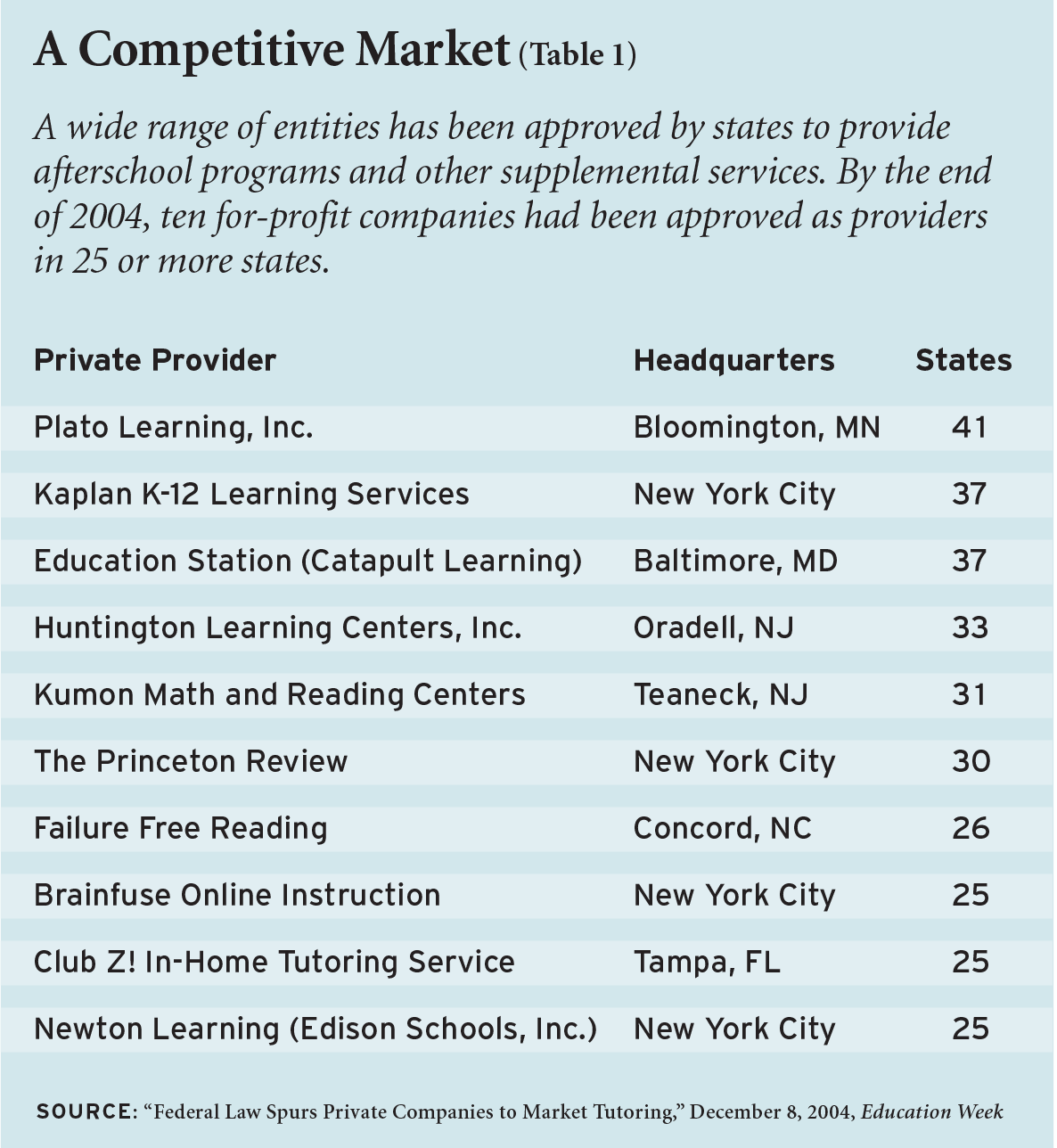
The Growth of the Afterschool Program
Despite disincentives to school districts, parental response has been surprisingly strong. Admittedly, fewer than 100,000 students participated in afterschool programs during the 2002–03 school year, according to Department of Education records. But the following year, that number doubled to 218,031, or 11.3 percent of all eligible students. As more students become eligible for afterschool services, and as word of the program spreads throughout disadvantaged communities, federal officials expect that number to continue to soar, with big gains expected as soon as the 2004–05 tally is made.
The supply of service providers is growing to meet the demand (see Table 1). Nationwide, more than 2,000 private entities now offer supplemental services. In most cases they teach small groups of students after the end of the regular school day. The degree of competition varies from one place to the next, the most intense being within big cities that have large numbers of eligible students. Some states, such as Florida and Idaho, report no students in thrice-failed schools and so have no one eligible to receive supplemental services. Other states, like California and New York, report hundreds of thousands of eligible students. Although boutique providers limit themselves to one or two locales, the largest companies, such as Kaplan, Princeton Review, and Plato Learning, are extending their reach into a majority of the states. Their energetic moves make good economic sense. Providers are finding that they can recruit quality teachers, develop effective curricula, put into place strong management systems, and still make a reasonable profit.
Given the still pent-up demand (in Illinois, for instance, only 5 percent of eligible students are getting supplemental services), the competition for the afterschool dollar will no doubt intensify dramatically with the passage of time. Only 2 percent of the $2.5 billion available for the supplemental services program has so far been tapped. With per-student costs averaging between $700 and $2,500, depending on location and other special circumstances, the number of students served could exceed 2,000,000.
In short, if private providers build on their initial successes, if school districts are unable to stop program growth, and if Title I funding continues its steady growth (see Figure 1), the afterschool program could expand to more than ten times its 2004 size. Just as Head Start began on a limited scale but has now spread to the point where well over half of all four-year-olds are in some kind of nursery or preschool program, so the afterschool program can be expected to take on a life of its own.
Many low-income families have quite practical reasons for finding afterschool services attractive, and they can be expected to seize this new opportunity to enjoy the same outside help as middle-class families have for their afterschool needs. For one thing, they provide a safe haven for a child during hours when most parents are still at work.
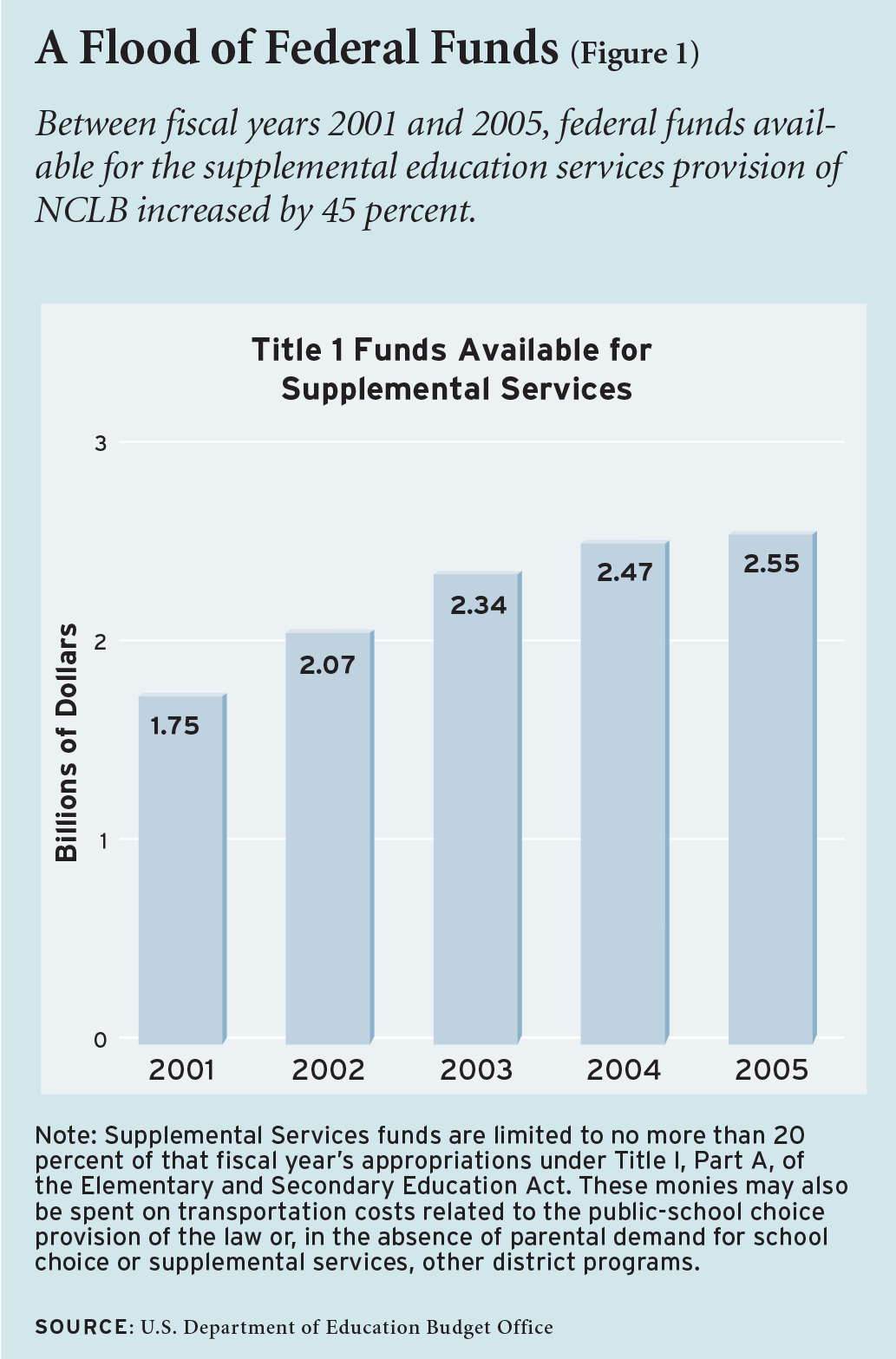
The Academic Potential
The afterschool option has educational attractions as well. Traditionally, after school has been considered a time for play, sports, or extracurricular activity, as well as for latchkeys, television, PlayStation, or life on the streets. Organized afterschool programs serving the disadvantaged have tended to focus more on snacks and recreational activities (basketball, roller skating, and gymnastics) than on reading, writing, and arithmetic.
Predictably, such programs have had little impact on academic progress. Both a review of traditional afterschool programs by Swarthmore economist Rob Hollister and a recent federally funded study conducted by Mathematica found little in the way of educational benefit from traditional afterschool activities. Only 50 percent of the directors surveyed in the Mathematica study saw “enhancing students’ ability to meet specific academic goals” as one of their top three program objectives. As Hollister concluded, “There is a tremendous struggle between those who believe that afterschool programs should be focused on skill development … and those who stress the need to provide an atmosphere for growth and adult contact for children who are too often ‘home alone.’”
Presumably, by explicitly identifying afterschool programs as a way of bringing all students up to the state-determined proficiency standard, NCLB has given after school the academic focus previous programs lacked. And by introducing a measure of choice and competition into the equation, providers place themselves at risk if they do not have educationally credible programming.
At this point, we don’t know what kind of academic lift these programs can offer. On the one hand, many of the afterschool programs are limited to only one to two hours a day over a three-month period. On the other hand, education providers have strong incentives — and few impediments — to make these moments educationally rewarding. Unlike the regular school day, the afterschool program is voluntary, not compulsory. Education providers, to secure their revenue flow, must find ways to persuade students to attend. Fortunately, voluntary attendance greatly reduces the problem disruptive students pose for inner-city teachers during the regular school day, when attendance is compulsory. And the afterschool teachers themselves can be hired outside the usual union rules and grievance structures. Providers can recruit regular public-school teachers for afterschool duty if they wish, but ineffective teachers can be readily dismissed. Meanwhile, the teachers enjoy the opportunity to work with those students who are motivated enough to sign up for the program. The conditions are such that the afterschool experience should, in most cases, be educationally positive.
Nor is there any inherent reason to think students cannot learn late in the day. After all, researchers have discovered that the biological clock of young people ticks faster later in the day than at the crack of dawn. (For older adults, it is just the opposite.)
We also know that privately run afterschool programs have long been key components of effective education in other countries, especially those that score high on international math and science examinations, such as Japan, Korea, Singapore, and Taiwan. Those countries have a widespread system of private, academically rigorous “cram” schools to which middle-class families send their students in order to enhance their opportunities for admission to college.
In short, strong parental demand, coupled with new suppliers entering an intensely competitive market, could boost the performance of those low-income students who are seeking ways to overcome their education disadvantages. Should that happen, the afterschool initiative could turn out to be the most important NCLB reform after all.
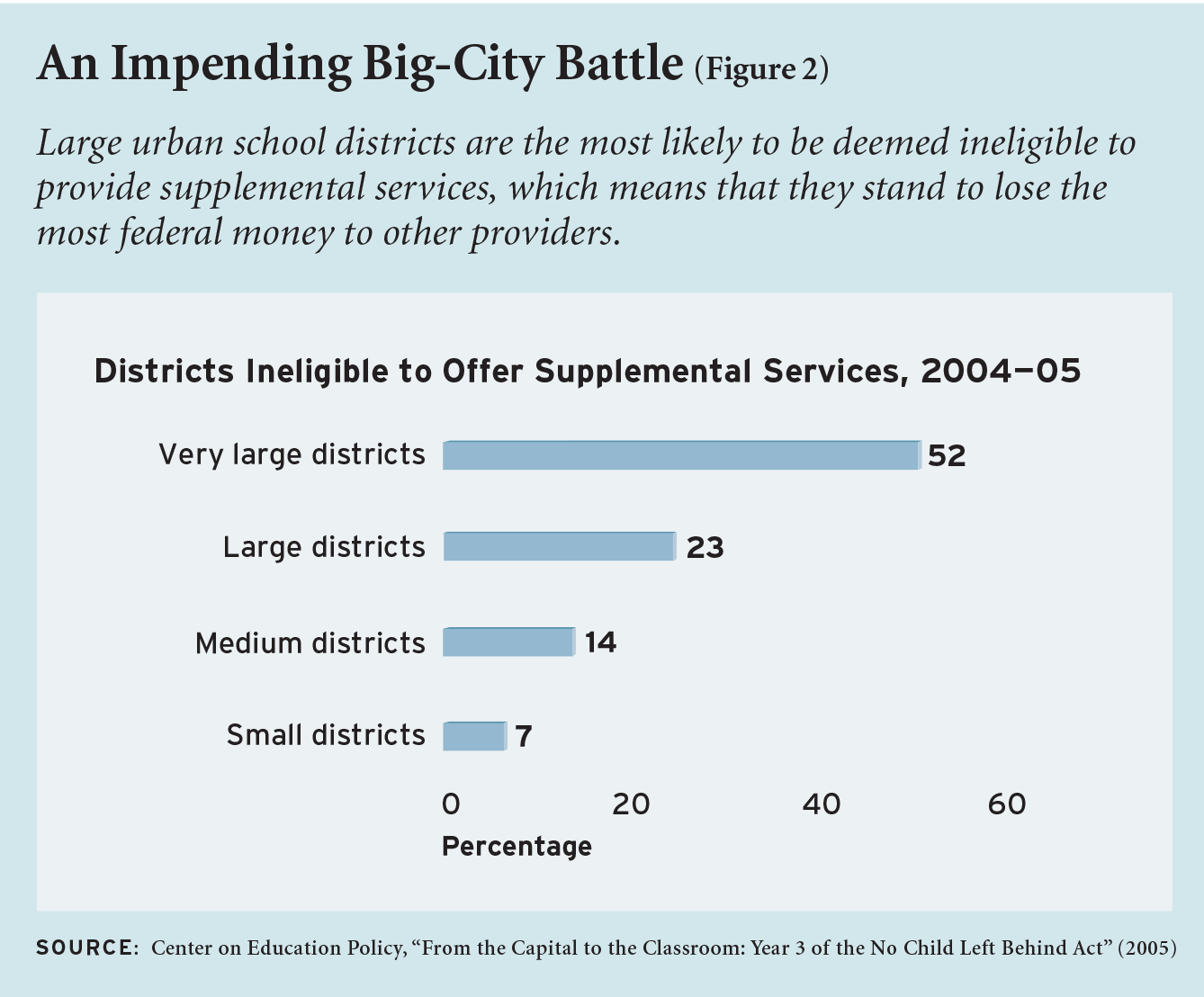
The Chicago Factor
For all their potential, and perhaps because of their potential, afterschool programs are fast becoming an arena for acrimonious political debate. And what better place to witness the rancor than the City of Broad Shoulders and Democratic dynasties: Chicago. In fact, under Mayor Richard Daley’s strong direction, the Windy City has, since the late 1990s, anticipated much of what would be included in NCLB. It has, for instance, required that 3rd graders pass an end-of-the-year exam (or boost poor scores by attending summer school) in order to advance to 4th grade.
One would expect Chicago to be among the strongest supporters of the new federal law on the question of afterschool academic programs except for one thing: despite some gains in student test scores in recent years, the Chicago school district, like many other big-city districts (see Figure 2), still has so few students making AYP that, under the federal law, the district has been designated as failing and thus cannot offer its own supplemental service programs.
The outcry from big-city school officials has been bitter. “When push comes to shove, we’re talking about children in desperate need of help,” a Chicago school administrator told an Education Week reporter last September. “Should we just cross our fingers and wait? These children need these services. They need these services yesterday.” Federal officials argued in response that if the school district can’t educate students during the regular school day, it’s time to let others have a chance after the bell rings.
Eventually the two sides reached a short-term compromise that allowed the Chicago school district to provide services itself in 2005 without suffering any serious financial penalty. But for future years, the issue remains on the table, with the feds, at least for now, continuing to insist that no failing school district be allowed to provide supplemental education services.
The federal focus on failing districts is understandable, given the way the law is currently phrased. But in terms of public policy, the central issue is not whether a district is failing but whether school districts should both offer services and control the terms of access by private providers.
The Financial Conflict of Interest
Though ignored in most of the public discussion, the financial conflict of interest is clear: school districts are given the authority to monitor afterschool education vendors even while acting as vendors themselves. If this arrangement were used in the banking industry, the Securities and Exchange Commission would also be a brokerage firm.
Admittedly, a district, if designated as failing, cannot offer the services itself. But that does not eliminate the conflict of interest. If parents are demanding afterschool services, then up to 20 percent of Title I funds given to that district must be used to fund the private providers offering the services. If parental demand for such programs is slight, then the failing school district may use the money for other purposes.
School districts have powerful weapons that can be used in the battle to limit the scope of the demand and control the provision of services. For one thing, privacy rules give districts exclusive control over communications with students and families. Although districts, by federal rule, must send a letter explaining the afterschool option to all eligible families, that letter, often sent late in the school year, is typically laden with the usual bureaucratic jargon. According to the Center on Education Policy study, “Parents thought the letters informing them about services were too long and complicated and buried key information.” As Michael Petrilli, a former federal education official has pointed out, “It takes very aggressive marketing to make low-income families aware of their options, and districts are not doing more than is required under the letter of the law.”
To be fair, not every district is proving obstreperous. On the contrary, a number of the largest, New York City included, are doing their best to inform parents of the options available to them. Even where cooperation is less clear-cut, it can in many instances be attributed to significant start-up problems. Schools are not identified as failing until the summer or well into the new school year in which afterschool services are to be made available. Districts must then organize their own afterschool programs or sign contracts with providers, then inform parents of services being offered.
But with a modicum of adjustments, those practical problems can be addressed, if districts are inclined to do so. Unfortunately, financial incentives and ingrained opposition to choice and competition push in the opposite direction. When asked for ways of improving NCLB, one administrator said, “Eliminate the Supplemental Services provision; it is very expensive and is of minimal value.” Union leaders are no less antagonistic. In New York, for example, the spokesman for the New York State United Teachers, the state’s largest teachers union, commented, “Our concern is that it is going to be difficult if not impossible to track whether or not this money is being spent effectively.” Although the point is well taken, teacher unions seldom show a similar kind of skepticism for most other kinds of school expenditure.
The animosity to the afterschool programs and other supplemental services was amply revealed in the Center on Education Policy survey of school administrators, who, when given anonymity, frankly stated their deep-seated suspicion of the profit motive:
“Supplemental Service funds should go to districts that would provide services without the profit motive.”
“I would not use federal funds to support a program being operated by individuals not held to the same standards that public school employees are held to.”
“Supplemental Services for any qualified provider will cause a cottage industry to develop that will be driven by profit and not academics.”
Suspicious of the private providers, mindful of the cost to their own coffers, and in control of the access channel, districts thus have both incentives and opportunities to check program growth. In Worcester, Massachusetts, for example, the school district, which offers its own afterschool programming, actively discourages other entities from offering their wares. Says one for-profit provider, “The school district is the owner of the relationship between provider and the parent. And I can’t get in.” In such cases, says Harvard professor William Howell, “It’s like asking a BMW dealer to extol the benefits of buying a Volvo.”
Such resistance to outside vendors is not limited to the districts in Senator Ted Kennedy’s home state. In testimony before a congressional subcommittee last May, Jeffrey Cohen, president of Catapult Learning, reported the numerous obstacles providers are facing nationally:
“We have seen parent notification letters that are impossible to decipher. We have seen multipart registration processes that seem to delay registration, rather than encouraging it. And, we have been prohibited from talking to school principals and parents.”
Districts are asked to hold “fairs” where competing providers can tell parents about their offerings, said Cohen, but, according to a high official at one of the major providers, “Districts do nothing beyond the bare minimum to promote the fairs to parents.”
When districts have financial incentives to limit participation, such obstacles make bureaucratic sense, however much they limit opportunities for families. Admittedly, private providers need to be monitored, so as to avoid “suede-shoe operators” from peddling their wares to unwary parents, a concern of Democratic representative George Miller, who serves as the ranking minority member of the House Education Committee. Some have been found to be paying parents to attend, and others have used a web site managed from overseas to work with students. As the program ramps up, all private providers need to demonstrate that their services are beneficial. But to turn the job of managing providers over to school districts that have an incentive to limit the competition defies all regulatory logic.
Of course, it cannot be left to the industry to monitor itself. But as long as districts have the monitoring authority, they can be expected to look for legal constraints that will keep the programs in-house. “There are some districts that are clearly not playing fair and have been a thorn in the side of the providers,” says Petrilli.
Despite tighter federal guidelines issued in June 2005, local districts still have a great deal of latitude when negotiating contracts with providers. As Michael Casserly, head of the Council of the Great City Schools, reports, “School districts and potential providers have found themselves tussling over the length of the contracts, per pupil fees, billing and payment procedures, staff qualifications, union rules, and the like.”
In short, the possibilities for burdensome regulations can be endless whenever the financial incentives to create obstacles are ingrained. As an administrator in Worcester explained, “We’re not required to provide transportation. And, to be honest, to send money out of the district, I’m not sure that we would even offer to do that.”
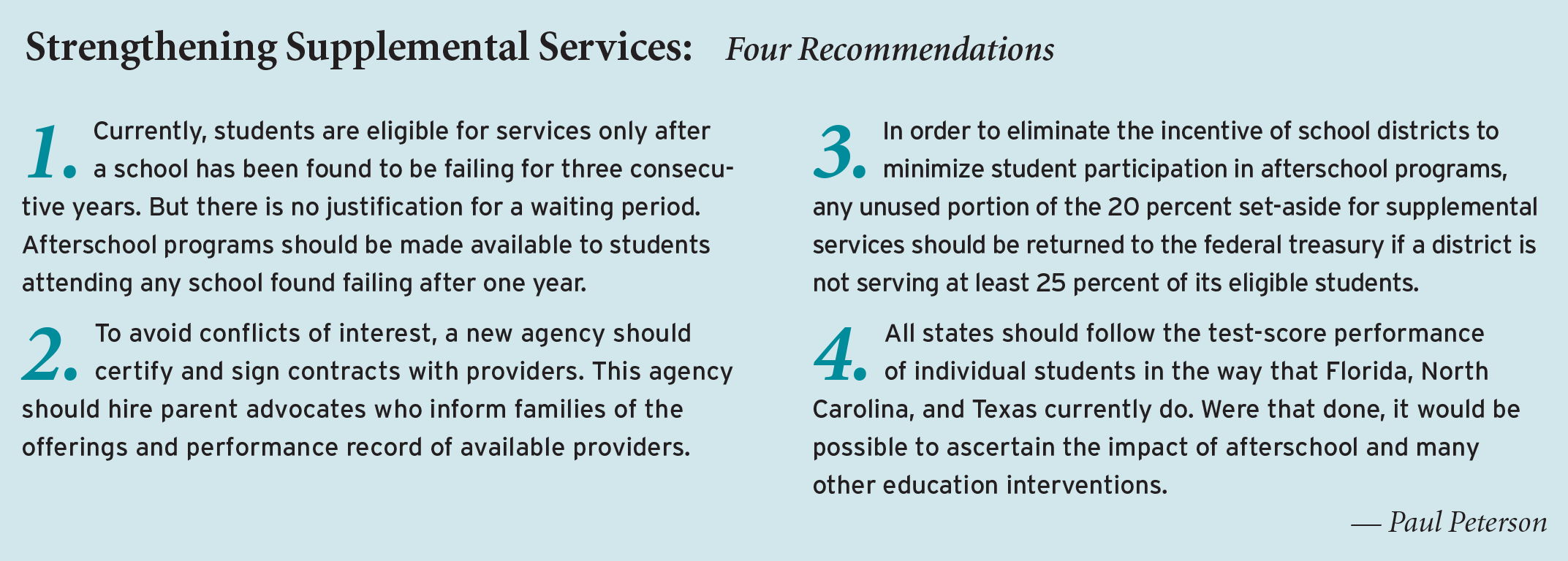
But Will Children Benefit?
How this power struggle will evolve, and whether students will benefit, remains the big unknown. Unfortunately, the accountability provisions of NCLB do not contain any mechanism for ensuring that students profit from afterschool programs, mainly because states are focusing more on overall school performance than on the performance of individual students.
If the NCLB accountability system can be gradually shifted to a student focus, then the impact of afterschool programs, along with much else, can become part of the planning for the future. Until then, one can expect private providers to claim great success without much convincing evidence. And school districts will complain about problems, corruption, and profit making with no more than an anecdote here and there to justify their self-serving complaints. But for those who think that choice and competition are the key to school reform, the afterschool intervention is the most promising vehicle currently available.
Paul E. Peterson is professor of government, Harvard University, and the editor-in-chief of Education Next.


